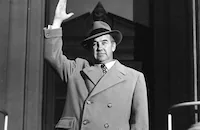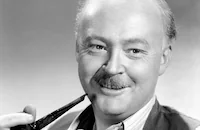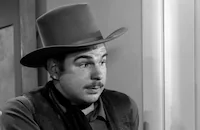Scandal Sheet

Brief Synopsis
Cast & Crew
Phil Karlson
Broderick Crawford
Donna Reed
John Derek
Rosemary Decamp
Henry O'neill
Film Details
Technical Specs

Synopsis
Ambitious New York Express reporter Steve McCleary delivers his latest scoop on a brutal murder to his executive editor and mentor, Mark Chapman, who is pleased. Chapman then attends a meeting called by stockholders upset by the paper's slide into tabloid excess, but Chapman points out that the steady rise of circulation is providing large dividends. When feature reporter Julie Allison loses a bet with Steve, she is forced to take him and Chapman out to dinner. On the way, the trio runs into Charlie Barnes, a formerly successful editor now on the skids, whom Julie tries to help. After dinner, Chapman and the others attend an Express -sponsored event called the Lonely Hearts Club, where singles are enticed by slick prizes to find a possible mate. Chapman is stunned when Charlotte Grant, the wife he abandoned twenty years earlier, approaches him from the crowd. Chapman agrees to speak with her and they go to her run-down room, where she demands an explanation for his behavior and change of identity. Chapman offers her a hasty divorce and settlement, but when Charlotte announces her intention to ruin Chapman by disclosing his past, he angrily shoves her against the wall, causing her to strike her head sharply against a pipe and die. Frightened, Chapman hastily removes all Charlotte's personal identification, a pawn ticket and the Lonely Hearts Club membership tag and destroys everything except the pawn ticket. The next morning, Steve is the first reporter at the murder scene and discovers pieces of the Lonely Hearts tag. After getting additional information from a contact at the morgue, Steve matches the crime photo with the Lonely Hearts Club's member photo, but still has no identification. He excitedly presents the photos and melodramatic story to Chapman, who shakily agrees to release an extra edition with a feature on the Lonely Hearts murder. Later that evening, Chapman goes to the pawnshop, but just outside runs into Charlie. Anxious to get rid of him, Chapman thrusts some money at the older man, not realizing the pawn ticket is included with the bills. Chapman hurries away and, curious, Charlie uses the ticket to claim a suitcase. Inside he discovers two framed photos, one of Charlotte with a man in profile, and the other of Charlotte and Chapman. Recognizing Charlotte from the newspaper account and realizing Chapman must be her murderer, Charlie hastens to a bar, where he calls Julie and declares he knows the identity of the killer. Certain that Charlie is drunk, she gives the phone to Steve, who laughs at Charlie's declaration and suggests he tell his story to the competing newspaper, The Leader . Meanwhile, in his office, Chapman realizes he has lost the pawn ticket and learns of Charlie's accusation from Steve. Charlie takes the photo of Charlotte and Chapman and leaves the other in the suitcase at the bar. A block away from The Leader offices, however, Charlie is stopped by Chapman, who demands the photo, then beats the older man to death. The next morning at the morgue, Steve, who is upset by Charlie's death and Julie's emotional response, investigates and quickly locates the suitcase, which, along with the remaining photo, includes papers with a marriage date in Connecticut. Steve takes the articles to Chapman and states that he believes the woman's husband is the man in the photo and that he must be the murderer. Chapman agrees to let Steve publish the photo and continue his pursuit, even posting a $1,000 reward for more information. Steve rounds up several tramps to get details about Charlie's final hours, and one man admits to seeing Charlie speaking with a man on the street outside the pawnshop. Steve brings the man to Chapman, but he fails to recognize him. Later that afternoon, Steve discovers that Julie has resigned and goes to her apartment to convince her to help him solve the case. She agrees to help him scour Connecticut records to find the judge or clergyman who married the couple in the photo. Chapman grows anxious, but allows Steve and Julie to go to Connecticut for a week, then calls Connecticut information to find Judge Hacker, with no results. After three days, Steve and Julie have no information, and Chapman orders them to return. Steve insists on staying the full week and shortly afterward receives a call from the retired Judge Hacker, who has a photograph matching the one posted. Steve wires Chapman and late that night at the Express offices, Steve and Julie bring in Judge Hacker, who has identified the photo as that of George and Charlotte Grant, a couple he married twenty years earlier. Chapman orders the judge to be placed in protective care at a local hotel, but when he offers to privately escort him, Judge Hacker refuses, having recognized him. Steve is incredulous, but Julie believes him and declares that traces of hair and skin under Charlotte's nails can support the judge's claim. When Chapman draws a gun and confesses, an appalled Steve calls the police. Lt. Davis arrives just as Chapman is giving Steve instructions on how to lay out the next day's paper with the confession headline. When Davis draws his gun upon hearing the details, Chapman turns and fires into the ground, and Davis shoots and kills him. With Steve's story about the Lonely Hearts murder in the morning paper, Express circulation hits an all-time high.

Director

Phil Karlson
Cast

Broderick Crawford

Donna Reed

John Derek

Rosemary Decamp

Henry O'neill

Henry Morgan

James Millican

Griff Barnett

Jonathan Hale

Pierre Watkin
Ida Moore
Ralph Reed
Luther Crockett
Charles Cane
Jay Adler

Don Beddoe
Shirlee Allard
Pat Williams
Raymond Largay
Edna Holland
Kathryn Card
Cliff Clark
Victoria Horne

Matt Willis
Eugene Baxter
Katherine Warren
Harry Hines
John "skins" Miller
Peter Virgo
Ric Roman
Tom Kingston
Charles Colean
Mike Mahoney
Gary Owen
Guy Wilkerson
Duke Watson
Harry Wilson
Ralph Volkie
Helen Brown
Crew
Clay Campbell
George Duning
Jack Goodrich
Burnett Guffey
Helen Hunt
William Kiernan
Eugene Ling
Jean Louis
Robert Peterson
James Poe
Ted Sherdeman
Edward Small
Morris Stoloff
Jerome Thoms

Videos
Movie Clip





Hosted Intro
Film Details
Technical Specs

Articles
Scandal Sheet
Phil Karlson and Samuel Fuller's Scandal Sheet (1952) exemplifies a certain strand of noir not the sweaty wrong-man-tripped-up-by-fate noirs (think Detour [1945], Somewhere in the Night [1946], Where Danger Lives [1950]), but the life-in-the-jungle noirs, dark elegies wherein citizens had to tough up to survive in modern urban sewers rife with impulse killing, squalor, crazed greed and moral desolation. Here, the systems themselves industry, community, the law, the mob, the press were rotten from the inside. Karlson and Fuller were reigning warriors in this vein: director Karlson was a no-nonsense journeyman who with Scandal Sheet, Kansas City Confidential (1952), 99 River Street (1953) and The Phenix City Story (1955) perfected a confrontational, violent, subtlety-immune noir style in which the world, not merely the individuals stuck in it, seemed to be on the edge of social upheaval. Fuller was, of course, Fuller, the most notorious idiosyncratic-pulpster of the postwar age, an unstoppable creative force whose particular view of the world was a vulgar, cynical mashup between first-hand realism (no American filmmaker knew the actualities of tabloid journalism, ground warfare and the criminal sector as well) and outrageous pop-cinema hyperbole.
Scandal Sheet, in any case, was not Fuller's film it was based on his hot-property novel The Dark Page, published in 1944 after Fuller had already defected from being a reporter to being a screenwriter, and while the young Fuller was fighting in Europe with the Big Red One. Still, it boils over with his storytelling energy and his signature reflex, the urge to discover, expressionistically, the painful, hard-boiled reality as he knew it within the movie universe of Golden Age Hollywood. The set-up itself is nearly autobiographical: Fuller used to work on the New York Graphic, a screaming-mimi, truth-manipulating exploitative tabloid on Park Row that makes the contemporary New York Post look like The London Review of Books. (Fuller has described its editorial principle to be one of "creative exaggeration.") It's easy to see how Fuller's own distinctive tale-telling style, visual and narrative, was formed by the daily creation of howling headlines, sensational fabrication and punchy, don't-lose-the-reader prose. In the film, Broderick Crawford's Mark Chapman is the New York Express's bulldog editor, pulling the daily out of its economic doldrums with lurid front pages and invented news; John Derek's Steve McCleary is his amoral star reporter, the two of them heading a newsroom that has only Donna Reed's Julie Allison to recommend it in the way of moral compunction and compassion. The thorny patter and amoral brio proceeds apace until Chapman is confronted at a publicity event by a middle-aged woman (Rosemary DeCamp), who immediately pegs him as "George," and summons an entire unwanted past that places Chapman's present success in mysterious jeopardy.
Soon it's made clear: she's the unstable wife he abandoned years before, and now she will not be ignored an ultimatum that leads, somewhat predictably, to a scuffle and her accidental death. From there, Chapman is all about covering his tracks, which as we all know simply creates more tracks, more corpses and more bad fortune. Scandal Sheet is a fast-gabbing, meat-eating show, with only one typical handicap: pretty boy star John Derek (future husband of Bo) is a baby-faced cipher beside the roaring rockface of Crawford, and even the quick-eyed beauty of Reed. But the story is expertly fashioned; Fuller was careful to make the tabloid mercenariness turn in on itself: McCleary is hot on the story, and despite his neck being in the noose Chapman must bait him on, because if he relents one iota from the Rupert Murdochian ethos that made him and the Express a hit, suspicion will fall on him like a safe from a window.
It's amusing to consider Fuller his industry's most uncompromised moralist, given his racy, flush-faced sensibility, but that's what he was and with Karlson's fast-&-knuckle-hard pacing, Scandal Sheet scans today like a prescient indictment of media sensationalism, Murdoch's and otherwise. "Thinking people," it is suggested, like Allison's humane feature stories, "even if there aren't many of them reading the Express anymore." Perhaps things haven't changed in the American mediascape, we may speculate, but perhaps things have grown many times worse the very idea of courting a "thinking" newspaper reader today is ludicrous, as monopoly regulations have all but vanished and only six corporations profit-maximizing, homogenizing, stockholder-focused own the vast majority of media outlets in the U.S., as compared to over 50 in 1983, and many hundreds in the 1950s. Fuller and Karlson had their ears to the ground in the mid-century, and however relevant it was in 1952 their movie feels like a prophecy come true.
Producer: Edward Small
Director: Phil Karlson
Screenplay: Eugene Ling, James Poe, Ted Sherdeman, Samuel Fuller (novel)
Cinematography: Burnett Guffey
Film Editing: Jerome Thoms
Art Direction: Robert Peterson
Music: George Duning
Cast: John Derek (Steve McCleary), Donna Reed (Julie Allison), Broderick Crawford (Mark Chapman), Rosemary DeCamp (Charlotte Grant), Henry O'Neill (Charlie Barnes), Harry Morgan (Biddle).
BW-82m.
by Michael Atkinson

Scandal Sheet
Quotes
Get her in here, we have to be at the ballroom at 8. No time for face powder.- Mark Chapman
We got a new man on this beat that's built like you between the ears. He saw a hole in the back of the dame's skull and figured she was slugged.- Lt. Davis
A very rare item. A picture of a dame with her mouth shut.- Steve McCleary
Write me a sob story. 'Miss Lonelyheart' won't be lonely anymore.- Mark Chapman
Trivia
Notes
The working title of the film was The Dark Page. A 1948 Los Angeles Times news item indicated that John Payne was set to star in the film for producer Sidney Buchman. Two years later a Hollywood Reporter item noted that William Holden was to co-star with Broderick Crawford for producer Jules Schermer. According to the same item, Ted Sherdeman was rewriting George Bruce's script, but Bruce's contribution to the final film, if any, has not been confirmed. Another 1950 Hollywood Reporter item announced that agent Arthur Landau was suing Columbia for $10,000, claiming to have presented the property to Schermer and the studio.
The same item revealed that author Sam Fuller was also in litigation against Famous Artists Corp. According to the news item, Fuller sold his novel, The Dark Page, to H-F Productions for $15,000, and director Howard Hawks spent $25,000 on pre-production for producer Jules Furthman. Monterey Productions later purchased the novel, then sold it to Motion Pictures Investors, Inc., which then sold it to Columbia for $10,000. In his suit, Fuller claimed the novel's worth was $100,000. A 1951 Hollywood Reporter item indicates that Fuller's successful production of The Steel Helmet revived interest in producing The Dark Page. Modern sources note that prior to his film career, screenwriter, producer and director Fuller was a crime reporter, novelist, tramp and soldier. The dispositions of Landau's and Fuller's suits have not been determined.















